Topics List
May 24, 2016 Updated
Handout for the Specialists advisory panel meeting called by MEXT (Ministry of Education, Culture, Sports, Science and Technology).
Apr. 28, 2016 Updated
Operation Plan of ASTRO-H (Hitomi)
|
JAXA established the emergency headquarters and has been doing its utmost to understand the anomaly of ASTRO-H (“Hitomi”). We have made every effort to confirm the status of ASTRO-H and to regain its functions. Unfortunately, based on our rigorous technical investigation, we had to conclude. JAXA have determined that we cannot restore the ASTRO-H’s functions. Accordingly, JAXA will cease the efforts to restore ASTRO-H and will focus on the investigation of anomaly causes. We will carefully review all phases from design, manufacturing, verification, and operations to identify the causes that may have led to this anomaly including background factors. JAXA expresses the deepest regret for the fact that we had to discontinue the operations of ASTRO-H and extends our most sincere apologies to everyone who has supported ASTRO-H believing in the excellent results ASTRO-H would bring, to all overseas and domestic partners including NASA, and to all foreign and Japanese astrophysicists who were planning to use the observational results from ASTRO-H for their studies. |
Apr. 21, 2016 Updated
Handout of press briefing (April 15)
Apr. 13, 2016 Updated
Handout of press briefing (April 8)
|
On April 8 (JST), JAXA held a press briefing to explain the status of the X-ray Astronomy Satellite “Hitomi” (ASTRO-H) and our activities to re-establish communications with “Hitomi.” |
Apr. 7, 2016 Updated
Handout of press briefing (April 1)
|
On April 1 (JST), JAXA held a press briefing to explain the status of the X-ray Astronomy Satellite “Hitomi” (ASTRO-H) and our activities to re-establish communications with “Hitomi.” |
Mar. 29, 2016 Updated
Current Status of Communication Anomaly of X-ray Astronomy Satellite “Hitomi” (ASTRO-H) (Mar. 29)
|
JAXA has been trying to communicate with the X-ray Astronomy Satellite “Hitomi” (ASTRO-H), using ground stations both in Japan and overseas. By utilizing two opportunities of communicating with Hitomi, JAXA received signals from the satellite: the first time was at about 10:00 p.m. on 28 at the Uchinoura Ground Station, and the second one was at around 0:30 a.m. on 29 at the Santiago Tracking Station in Chile. JAXA has not been able to find the state of its health, as the time frames for receiving the signals were very short. According to the U.S. Joint Space Operations Center (JSpOC), it is estimated that Hitomi separated to five pieces at about 10:42 a.m. on 26. In order to investigate the situation, JAXA is observing the objects, using a radar located at the Kamisaibara Space Guard Center (KSGC) and telescopes at the Bisei Space Guard Center (BSGC) owned by the Japan Space Forum. Up to now, the telescopes at BSGC detected two objects around the satellite’s original orbit, while the radar at KSGC identified one of them. It is confirmed that the signal received at the Santiago Tracking Station came from the orbital direction of the object identified at KSGC. JAXA continues to investigate the relationship between the information from JSpOC and the communication anomaly. JAXA will do its utmost to recover communications with Hitomi and investigate the cause of the anomaly.
|
Mar. 27, 2016 Updated
Communication anomaly of X-ray Astronomy Satellite “Hitomi” (ASTRO-H) (Mar. 27)
|
JAXA found that communication with the X-ray Astronomy Satellite “Hitomi” (ASTRO-H), launched on February 17, 2016 (JST), failed from the start of its operation originally scheduled at 16:40, Saturday March 26 (JST). Up to now, JAXA has not been able to figure out the state of health of the satellite. While the cause of communication anomaly is under investigation, JAXA received short signal from the satellite, and is working for recovery. Under this circumstance, JAXA set up emergency headquarters, headed by the President, for recovery and investigation. The headquarters held its first meeting today, and has been working for recovery and the investigation of the cause. Updates will be announced as available, at the JAXA website. |
Feb. 29, 2016 Updated
Hitomi critical operation phase successfully completed!
|
JAXA confirmed the completion of a sequence of important operations of the X-ray Astronomy Satellite “Hitomi” (ASTRO-H), including turning the cooling system on, test operation of the Soft X-ray Spectrometer (SXS), and extending the Extensible Optical Bench (EOB). With this confirmation, the critical operation phase of Hitomi was completed. |
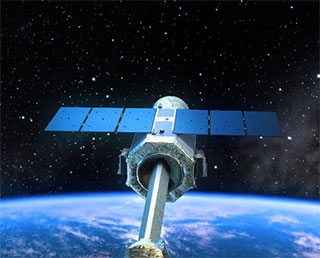 |
|---|
Feb. 17, 2016 Updated
ASTRO-H successfully launched and named “Hitomi”.
|
H-IIA F30 with the “ASTRO-H” onboard launched at 5:45 p.m. on Feb 17, 2016 (JST) from the Tanegashima Space Center. The rocket flew smoothly, and, at about 14 minutes after liftoff, “ASTRO-H” was separated from the H-IIA F30. |
 |
|---|
Feb. 14, 2016 Updated
ASTRO-H Launch rescheduled to 5:45 p.m. on Feb 17 (Wed. ,JST)
|
The launch of the The X-ray Astronomy Satellite “ASTRO-H” by the H-IIA Launch Vehicle No. 30 was rescheduled at 5:45 p.m. on Feb 17 (Wed. Japan Standard Time, JST) after carefully studying the weather conditions. The live launch report will begin at 5:25 p.m. on Feb 17(Wed. ,JST). The report will be broadcast through the Internet. |
 |
|---|
Feb. 12, 2016 Updated
The X-ray Astronomy Satellite “ASTRO-H” launch postponement
|
H-IIA Launch Vehicle No.30 with the X-ray Astronomy Satellite “ASTRO-H” onboard, which was originally scheduled for February 12 (Fri.), 2016 (Japan Standard Time), has been rescheduled because bad weather is expected. The new launch day will be announced as soon as it is determined. Your warm support messages are welcomed at the support site. |
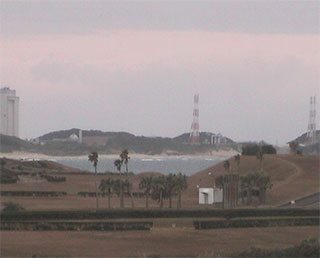 |
|---|
Feb. 3, 2016 Updated
ASTRO-H Press Kit
|
As the launch day approaches, JAXA has released the press kit for the X-ray Astronomy Satellite “ASTRO-H”. It covers ASTRO-H’s satellite and mission overview, scientific missions, and observation instruments. Please have a look. |
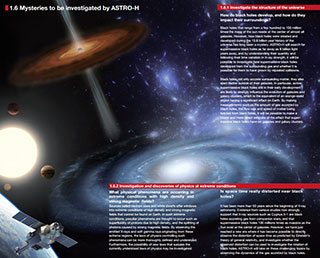 |
|---|
Jan. 21, 2016 Updated
ASTRO-H’s development and preparation status is updated on the ASTRO-H diary site
|
Aiming at the launch and success of the mission, for some years the Astro-H team members have been hard at work at research and development, making steady progress. They have faced many tough obstacles along this long road. They have had many moments of success. |
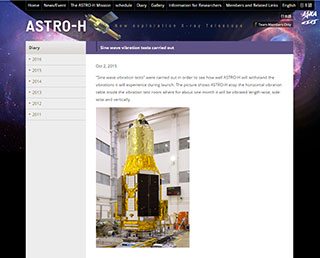 |
|---|
Jan. 12, 2016 Updated
ASTRO-H Satellite Shown to the Public
|
On the day marking exactly one month to launch, the ASTRO-H spacecraft was exhibited to the public at the Tanegashima Space Center. Many questions were asked both about the science goals of ASTRO-H and about its engineering. |
 |
|---|
Dec. 11, 2015 Updated
X-ray Astronomy Satellite “ASTRO-H” to be launched on Feb. 12
|
The new generation X-ray astronomy satellite ASTRO-H is set for launch on February 12 (Fri.), by the H-IIA Launch Vehicle No. 30 from the Tanegashima Space Center. JAXA will broadcast a live launch report on the launch day. We will announce more details later. Please look forward to the launch! |
 |
|---|
Dec. 2, 2015 Updated
ASTRO-H press day
|
The X-ray Astronomy Satellite “ASTRO-H” was revealed to the media on Nov. 27 at the Tsukuba Space Center. |
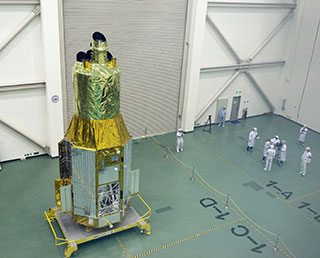 |
|---|
Nov. 2, 2015 Updated
ASTRO-H sinusoidal vibration test
|
The sinusoidal vibration test of the X-ray astronomy satellite “ASTRO-H” was held between Aug. 29 and Oct. 2 at the Tsukuba Space Center. The sinusoidal vibration test aims at two major evaluation objectives, namely evaluating dynamic characteristics of a satellite structure and assessing its strength by loading vibrations equivalent to that at the launch. |
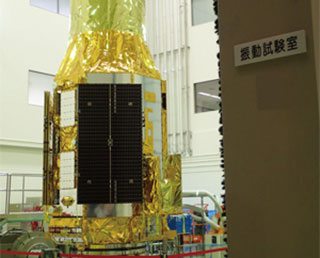 |
|---|
Aug. 3, 2015 Updated
ASTRO-H thermal vacuum test
|
The thermal vacuum test was held for the X-ray Astronomy Satellite “ASTRO-H” between June 24 and July 9 in a 13-meter chamber at the Tsukuba Space Center. The purposes of the thermal vacuum test are to verify the thermal model by exposing a satellite to the vacuum and thermal environment, and to confirm the function and performance of observation instruments in the on-orbit environment through an electric test. |
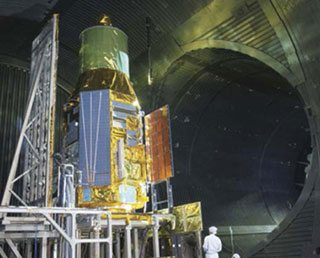 |
|---|
Apr. 21, 2015 Updated
Soft Gamma-ray Detectors (SGDs) installation on ASTRO-H completed
|
Two Soft Gamma-ray Detectors (SGDs), which successfully went through the thermal vacuum test and the cooling test, were installed onto the ASTRO-H. The photo shows the SGD2 on the ASTRO-H with a debris cover and a radiator. A golden color MLI (multi-layer insulation) will wrap them so that they will not be seen from outside. |
 |
|---|
Jan. 25, 2015 Updated
Thermal vacuum test for Soft Gamma-ray Detectors
|
The Soft Gamma-ray Detectors (SGD) to observe the soft gamma-ray region of 60 to 600 keV are under the thermal vacuum test in the 8-meter chamber at the Tsukuba Space Center to confirm their thermal design. |
 |
|---|
May 29, 2014 Updated
First Integration Test for ASTRO-H (for XRT)
|
As manufacturing of two Hard X-ray Telescopes (HXTs) and two Soft X-ray Telescopes (SXTs) has been completed and their performance has been confirmed, they are going to be subject to the first integration test. During the test, the telescopes will be mounted on an optical board to make sure that there is no interference with other structures or the satellite bus as well as that no problems arise with operations for controlling the telescope position or angle and operation tools. |
 |
|---|
Mar. 26, 2013 Updated
ASTRO-H development status
Aug. 10, 2012 Updated
Satellite development going well: Development test status
Mar. 15, 2010 Updated
ASTRO-H passed the basic design review, new logo published
|
On May 13 and 14, 2010, the basic design review was held for the ASTRO-H, and the satellite passed the examination. We are moving to the detailed design phase. To celebrate this opportunity, we revised the official logo mark for the ASTRO-H and published it on Feb. 25. The launch of the ASTRO-H is coming closer, and we are working hard for the project to proceed smoothly. Your support will be very much appreciated. |
 |
|---|
Oct. 28, 2009 Updated
SRON-JAXA agreement on Space Science
|
On October 28th, 2009, SRON Netherlands Institute for Space Research and JAXA signed a cooperative framework agreement with the aim of promoting joint activities in the field of space science in the presence of Dr. De Heer, the Ambassador Extraordinary and Plenipotentiary of the Kingdome of the Netherlands to Japan, and Dr. Tachikawa, the President of JAXA. |
 |
|---|
Comments are closed.